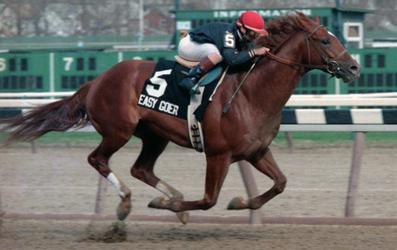
The Gotham Stakes had long been a stepping stone for good horses moving on to do great things. Recently the race has fallen from grace so to speak, and has not exactly been the most productive for horses moving on to better. That said, the great history of the Gotham remains. Native Dancer won the race in 1953 during a career that would only see him face defeat once. Dr. Fager won the Gotham Stakes in 1967 as the first race of his nearly undefeated three-year old season. Secretariat won the race in 1973 in route to his iconic Triple Crown sweep.
It is only right that Easy Goer would win the 1989 Gotham Stakes during a year that would see him six Grade 1 races.
Easy Goer was bred in Kentucky by Ogden Phipps and foaled on March 21, 1986. He was a handsome son of the always-trying Alydar out of the champion Buckpasser mare Relaxing. Easy Goer, though beautiful, was known for having upright pasterns, enlarged ankles, and a clubbed foot. These faults could be known to give him problems during his races, but had a deadly ability to run down his foes in the stretch.
The colt began his early training at Payson Park Training Center in Indiantown, FL with Shug McGaughey. He immediately impressed onlookers with his muscular build and obvious superiority to the other horses he was training alongside. It was no surprise that this colt would become a superstar.
The chestnut colt lost his maiden debut by a nose at Belmont Park in August of 1988. He must have decided that he didn’t like the taste of defeat as he mowed down horses in his next four starts. These victories included the Cowdin Stakes (G1) and Champagne Stakes (G1).
The only loss Easy Goer would face as a two-year old came in the Breeders’ Cup Juvenile; he was able to pass all but one horse, Is It True, in his signature stretch run at Churchill Downs. It was the final race of his two-year old season. Despite his loss in the Breeders’ Cup, Easy Goer was named 1988’s Champion Two-Year Old Colt.
Easy Goer made his seasonal debut in the Swale Stakes at Gulfstream Park, winning by 8 ¾ lengths before shipping back to New-York for the Gotham Stakes (G2). His great-grandsire, Native Dancer, had won the race in 1953 and Easy Goer’s connections were hoping that he would follow in his footsteps.
The colt was favored to win the Gotham, but few expected him to win it in the way that he did. Easy Goer smashed his foes by 13 lengths in a time of 1:32 ⅖, breaking Secretariat’s stakes record and Forego’s track record.
If the colt had any doubters then, they were almost certainly won over after that breathtaking performance. The son of Alydar didn’t stop there – he won the Wood Memorial Stakes (G1) by more than three lengths in his final start before meeting Sunday Silence in the Kentucky Derby.
Easy Goer had raced just thirteen days before the First Saturday in May, but that didn’t sway the bettors from making him the favorite. He broke well from the gates and was able to settle in fifth position as they went around the far turn. Unfortunately, things didn’t go as planned when the field went into the stretch.
Easy Goer couldn’t seem to make up enough ground in the stretch to catch Sunday Silence and ended up finishing second. His connections contributed his loss to a crack on his left, front heel that caused him discomfort as well as the muddy Churchill track that Easy Goer struggled to get good footing on (similarly to his loss in the Breeders’ Cup Juvenile).
Even after the tough loss in the Kentucky Derby, Easy Goer’s connections weren’t going to give up on him. They knew that their colt was capable of winning one of the Triple Crown races. They kept his hooves soaking in Epsom Salts to help the cracks in his hooves up until the day leading up to the Preakness Stakes. They hoped that it would help him run better than he had in the Kentucky Derby.
They also had another plan to defeat Sunday Silence – they knew that Easy Goer lacked the tactical speed that Sunday Silence had. In order to defeat him, they would need to be closer to him. Jockey Pat Day ensured that Easy Goer was close behind Sunday Silence throughout the entire race. The duel that would ensue between Sunday Silence and Easy Goer in the stretch of the Preakness Stakes is one of the story books. As the field turned for home, Easy Goer had his head in front. But, Sunday Silence was looming close behind.
The two colts hit the top of the stretch together. Both fought their hearts out until they crossed the wire, neither willing to give up or give in. But Easy Goer had once again been defeated — this time it was only by a nose.
Finally back in New York for the Belmont Stakes, Easy Goer was determined to not be defeated. He ran just behind Sunday Silence in third, watching his foe’s every move. When the field hit the far turn, Easy Goer soared past Sunday Silence and charged down Belmont’s stretch like a freight train. He widened his advantage with every stride until he crossed the wire, eight lengths ahead of Sunday Silence in second.
His time of 2:26 meant that he had run the second fastest Belmont Stakes in history, just behind Secretariat. Easy Goer had finally gotten the classic victory that he had fought so hard for.
Easy Goer would go on to win four consecutive Grade 1 races after the Belmont Stakes: Whitney Handicap, Travers Stakes, Woodward Handicap, and Jockey Club Gold Cup. Three of those four races were against older horses.
The 1989 Breeders’ Cup Classic was slated to be Easy Goer’s final race of his three-year old season. It would also be the next and final time that he would face Sunday Silence. With Horse of the Year honors on the line, Easy Goer charged at Sunday Silence in the stretch with everything he had within him. He simply didn’t have enough time; Sunday Silence won by “a desperate neck”.
Because of his Breeders’ Cup victory, Sunday Silence was named Champion Three-Year Old and Horse of the Year. Nevertheless, Easy Goer had become the only horse in history to win the Whitney, Travers, Woodoward, and Jockey Club Gold Cup in the same year. He had defeated older horses on multiple occasions, something horses his age rarely did.
Easy Goer began his four-year old season with an easy romp in the Gold Stage Stakes. He followed it up with an uncharacteristic third place finish in the Metropolitan Handicap. It would be the only time that he would finish worse than second in his entire career.
The big chestnut made the final start of his career in the Suburban Handicap (G1) before retiring due to a bone chip in his ankle. The undsoundess issues that had plagued his entire career had finally put an end to the reign of Easy Goer. He was sent to his home of Claiborne Farm to begin his stud career in 1991.
Easy Goer would sire 74 winners before his untimely death in 1994 due to anaphylactic shock. An autopsy had also revealed that the horse had been suffering from cancer at the time of his death.
With the Gotham Stakes (G3) being run this weekend at Aqueduct Racetrack, the racing world will reflect on the many great horses who have won the race in the past. They will fondly remember Easy Goer, the race’s record holder. They will reflect on all the heart, class, and talent he had and wonder if the next big horse will emerge.
By Kaeli Bartholomew



